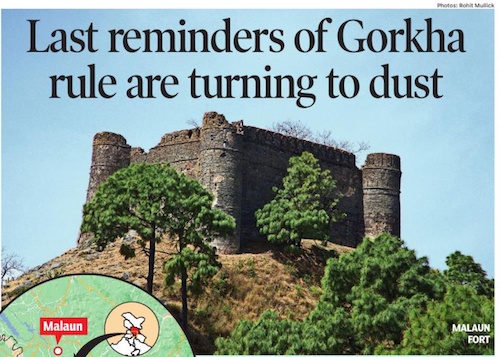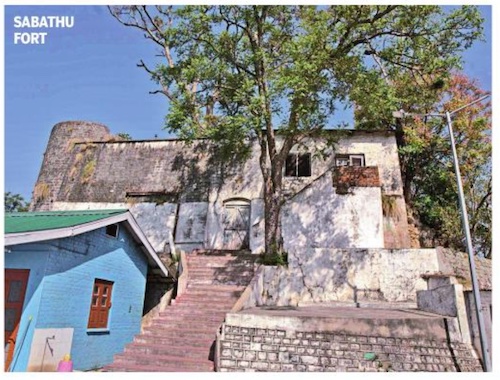Himachal Pradesh: history
This is a collection of articles archived for the excellence of their content. |
Gorkha rule
A backgrounder
Rohit Mullick, March 24, 2024: The Times of India

From: Rohit Mullick, March 24, 2024: The Times of India

From: Rohit Mullick, March 24, 2024: The Times of India

From: Rohit Mullick, March 24, 2024: The Times of India

From: Rohit Mullick, March 24, 2024: The Times of India
At the beginning of the 19th century, the Gorkha army of Nepal overran the hills of Himachal Pradesh. Although the British dislodged them before long, the Nepalese left behind a legacy of Gorkha forts in the state. But now, more than 200 years later, these forts are crumbling. Wild bushes and trees have invaded their grounds while the walls have developed huge cracks.
If the forts disappear, it will be an irreparable loss, said Arun Kumar Singh, professor of history and archaeology at Himachal Pradesh University in Shimla. “Himachal Pradesh has a history of Gorkha rule, and these forts are a witness to that time and age. You just can’t abandon these structures and leave history in ruins,” he said.
Still, it’s not too late to witness these relics of an almost-forgotten past as three of the forts – Banasar, Sabathu and Malaun – are situated in Solan district, known all over for the hill station of Kasauli, and are not far from Chandigarh. Banasar: This fort defended the Gorkha army’s outpost overlooking the plains of Punjab and Haryana, but today there’s no sign to lead visitors to it at Banasar village near Kumarhatti. It’s a rickety edifice with cracks running along the inside walls of the watchtowers at its four corners. As there’s no caretaker, visitors have scratched their names on its walls.
Malaun: This fort commands a hilltop near Swarghat on the boundary with Bilaspur district. It was here that one of the last and decisive battles of the Anglo-Nepalese war was fought in 1815. British troops under David Ochterlony cut off supplies to the fort. This move, combined with superior British firepower and numbers, forced Gorkha commander Amar Singh Thapa to surrender the Malaun fort while his son Ranjor Singh surrendered the Jaithak fort of Nahan in Sirmaur district. After this, the British raised Nasiri, their first Gorkha battalion, from members of the defeated Nepalese army.
Today, a part of the Malaun fort has collapsed, while a tem- ple has gradually encroached upon it. A dharamshala and temple buildings stand over the old fort rooms. Another collapsed part of the fort is being dug up to make more temple rooms. Jai Dev, a panchayat member in Malaun, said he’s saddened by the fort’s decay. “They even took away its two British-era cannons. If govt doesn’t repair it soon, there won’t be any fort left at Malaun in a few years,” he said.
Sabathu: A few years ago, the Malaun guns were brought to the Gorkha Training Centre in Sabathu, a famous cantonment since British times. Now the Gorkha fort at Sabathu is also falling apart and a temple stands on the site. When TOI mentioned the decaying forts to Solan deputy commissioner Manmohan Sharma, he said there’s no plan to restore them, but he promised to talk to the tourism department about it.
THEY RULED GARHWAL, KUMAON TOO
Before it took the hills of modern-day Himachal, the Gorkha army had conquered the Kumaon region of Uttarakhand by 1791, followed by Garhwal to its west by 1804. Led by their general Amar Singh Thapa, the Gorkhas ruled a vast expanse of Himachal between 1803 and 1815, covering Sirmaur, Shimla, Solan and Kangra districts. Thapa had made Arki in Solan district, a princely state known for its miniature paintings, his capital. He built forts in this territory as outposts and a symbol of Gorkha dominance. But the British put an end to his ambitions in 1815.